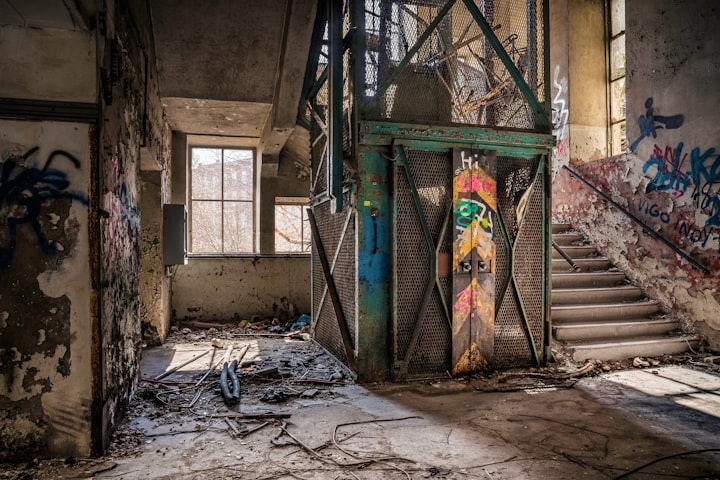The Psychology of The Haunting of Hill House
Analyzing a Horror Classis

It's rare for a novel to genuinely earn the term “psychological horror.” Haunted house stories, along many others in the horror genre, tend to rely on our more primal responses to make an impression. Vampires, serial killers, and demonic spirits can be used effectively to disturb us, but rarely do creatures like these confront a person's identity, persona, and insecurities so palpably. With Shirley Jackson's novel, however, these are the essential elements at play. Through the delicate language used to express her characters' thoughts and feelings, built up with layers of personal experiences exacerbated by inexplicable forces, we're given a story that turns out the psyches of those characters for us to feel, empathize with, and above all, to share in their terror.
Regarded now as a classic, and possibly the best haunted house story ever told, it may be worth examining just how the novel manages to cast such a gripping spell on its readers. There's something uniquely frightening about the relationship between the house itself and the characters within it. Without spoiling too much, we can try to analyze these elements and see how Shirley Jackson weaves them into a comprehensive work of supernatural, psychological horror.
An American “Gothic”
As many fans of classic horror literature would tell you, there are real social and political implications in the term “Gothic.” The old Gothic castle, home to vampires or gluttonous nobles with occult obsessions, is a trope long-used to invoke a common fear. The cruelty of the aristocratic class, portrayed as vampires sucking the blood of peasants or merciless lords willing to sacrifice their subjects to achieve their own ends. These structures towered over towns, a constant reminder of one's oppression and the unspeakable things that may have happened there. As the aristocracies of the world fell, their castles and towers remained, and for their reputation became the subject of hauntings and the homes of monsters; living memories of despotic elites feeding on the common folk.
Hill House is likewise an expression of wealth and privilege. A structure designed by the rich, eccentric, and most probably disturbed Hugh Crain. A man we learn little about, other than his fierce desire to impose his unconventional aesthetics on his family home. Everything about its style, its location, its furnishings, and its owners invoke a new kind of Gothic for the 20th century. The familiar old-school luxuries of the house, albeit odd and disfigured in many ways, are unmistakably characteristic of the opulence and prestige of American high society. Like the Gothic castles of old, it too is left behind by its affluent owners; but in this case accompanied by “a history of suicide, madness, and lawsuits.”
A House Born Bad
From the moment we encounter Hill House, we're immersed in its presence. Right away we're confronted with more than just its atmosphere; we're confronted with its mood, its personality, the authority it imposes on all those who enter. We find it secluded behind thick forest and hills, appearing suddenly at the end of a long winding driveway beyond a black iron gate locked with chains. As each character arrives, we experience their immediate impressions, noting that each of them are immediately repulsed by the place in their own way. Learning the houses history, we seem to learn more about its personality than about its true nature. We can never be sure what kind of presence really lurks there, or what it really does, but we can almost feel its guileful animosity.
In a typical haunted house, we may expect to find a ghost or spirit with some unresolved conflict or grudge. By the time these ideas are presented to us in the narrative, we already know that isn't the case. The behavior of Hill House is inexplicable, whatever presence it contains cannot be named, quantified, or explained; only experienced. To Eleanor, the house seemed to have formed itself as a place devoid of kindness, opposed to human habitation. As Doctor Montague says, “The evil is the house itself, I think. It has enchained and destroyed its people and their lives, it is a place of contained ill will.”
Eleanor, Come Home
Eleanor Vance, our point-of-view character, is our vicarious representative through whom we experience the house . Consequently, it's her thoughts and feelings we become the most familiar with. Eleanor is a person without a life of her own, who's insecure with others because she rarely interacted with other people. From the start we see that she is sensitive, somewhat unhinged from reality, and mostly unhappy. These qualities are an essential part of the story, because they're the basis of how she expresses herself throughout the novel, and the tools that Hill House manipulates to impose its will.
1. I Have A Cup Of Stars
Over and over, we see Eleanor identifying with objects that stand out to her. Before reaching Hill House, we follow her into a restaurant where she overhears a child screaming for her cup of stars, for her milk. We know this makes an impression on Eleanor, as we see her bringing it up again throughout the narrative. She tells the others that she herself has a cup of stars, and she imagines actually having it or finding it one day to herself.
Time and again, anything that stands out from what's around her, becomes a part of who she is. “I'm wearing red shoes,' she thinks, “That goes with being Eleanor.” This thought comes not long after contemplating how good she feels being apart of the group at Hill House, despite its oppressive atmosphere. Throughout the story, we experience her fierce desire to be a distinguished part of the greater whole. What distinguishes her is what makes her feel present and alive, but it doesn't reveal anything about who she really is. Ironically, what makes her feel part of the group also separates her, preventing her from creating any close bonds.
“She wants her cup of stars,” the mother explains. “Indeed yes,” Elanor thought; “indeed, so do I; a cup of stars, of course.”
2. Journeys End in Lovers Meeting
Another motif of Eleanor's is to repeat the lyrics “journeys end in lovers meeting.” She sings it to herself upon leaving for Hill House and throughout her time there. We know she's agreed to go to Hill House with the others because she's essentially never had a life or a story of her own. To her, it's a chance for something to happen, to live for herself for once, to feel part of something. The whole experience is a journey, which as she tells herself, ends in lovers meeting.
Having found herself new company at Hill House, we see how quickly she takes to being part of the group. To her, it's like finding the family and home she never had. She came to the house with nothing to return to; no friends, no job, and no one who cares for her. What's terrifying, and also sad, is that we come to see how vulnerable this makes her. Her heart is set on finding love, or at least acceptance, on this journey, and there's nothing else for her to gain or lose.
“Journeys end in lovers meeting, she thought, standing on the steps of Hill House, journeys end in lovers meeting, and she put her foot down firmly and went up to the veranda and the door.”
3. I'm Happy! It Wants Me Here!
As the tale goes on, we see Eleanor become more and more detached from the others and more aware of Hill House's behavior. What's more, is that incidents in the house cause her to stand out, playing both into her own self-perception and the way the others actually regard her. The house seems to single her out, and the others come to perceive her distinctions as shallow vanity. The more she feels them others pulling away from her, the more perceptive she becomes of what's going on inside the house.
The tragedy is that Hill House ultimately does become the home Eleanor is looking for. She submits to it, surrenders herself, because the house has isolated her from those who she was desperate to feel close with. Without them, only the house itself remains. She has nothing and no one else to turn to, and is so readily willing to attach herself to anything that makes her feel distinguished. Her “possession” is so rapid because her loneliness and insecurity make it easy to isolate her from the others and, ultimately, to turn her against them.
“I have broken the spell of Hill House and somehow come inside. I am home, she thought, and stopped in wonder at the thought. I am home, I am home, she thought;”
Haunting The Human Psyche
What's striking about the novel is that though disturbing occurrences happen throughout, we're never presented with any real tangible threat. Almost all we're given are the sounds, thoughts, and feelings experienced by the characters. It's a horror story without monsters, gore, or violence of any kind. Instead, we have a comprehensive experience of the main characters' emotional tension, their anxieties, and their flaws.
We watch our protagonist's persona unravel, exacerbated by the incomprehensible powers of a malevolent structure made by human hands. We watch a person's desires and insecurities being subtly manipulated and leading them into the designs of a hostile force. We're reminded of the vulnerabilities of the human mind, how these familiar feelings can cause people to think and act in dangerous ways. We wonder, if we were in Hill House, how might we fare with our most intimate insecurities turned against us?





Comments
There are no comments for this story
Be the first to respond and start the conversation.